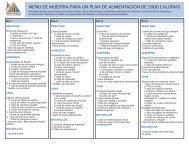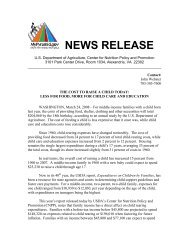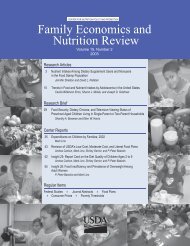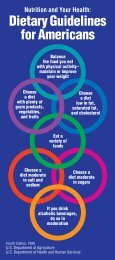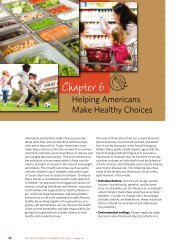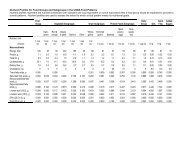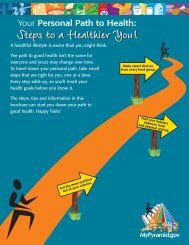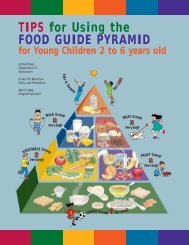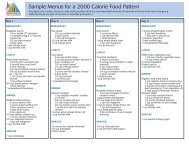Elderly Nutrition - Center for Nutrition Policy and Promotion - US ...
Elderly Nutrition - Center for Nutrition Policy and Promotion - US ...
Elderly Nutrition - Center for Nutrition Policy and Promotion - US ...
You also want an ePaper? Increase the reach of your titles
YUMPU automatically turns print PDFs into web optimized ePapers that Google loves.
the Georgia Division of Aging Services<br />
<strong>and</strong> Wellness, Inc., <strong>and</strong> focused on<br />
correcting risk factors <strong>for</strong> poor nutrition<br />
in older adults <strong>and</strong> facilitating the<br />
voluntary adoption of eating behaviors<br />
that promote health <strong>and</strong> well-being<br />
<strong>for</strong> older adults. The key themes of<br />
this curriculum—centering on the<br />
program’s three campaign messages:<br />
Take 5 a Day, Take Down Fat, <strong>and</strong><br />
Take Action—were established by the<br />
Georgia Coalition <strong>for</strong> Physical Activity<br />
<strong>and</strong> <strong>Nutrition</strong> (Georgia Coalition <strong>for</strong><br />
Physical Activity <strong>and</strong> <strong>Nutrition</strong>, 2002)<br />
<strong>and</strong> followed the principles of the Food<br />
Guide Pyramid (<strong>US</strong>DA, 1996) <strong>and</strong> the<br />
Dietary Guidelines <strong>for</strong> Americans<br />
(<strong>US</strong>DA & DHHS, 2000).<br />
The 12 lessons of “Take Charge of<br />
Your Health <strong>for</strong> Older Adults” included<br />
topics such as heart disease <strong>and</strong> high<br />
blood pressure, calcium <strong>and</strong> osteoporosis,<br />
diabetes, <strong>and</strong> nutrition <strong>and</strong><br />
cancer prevention. The five leg<br />
exercises consisted of toe raises <strong>for</strong><br />
the calf muscles, side-leg lifts <strong>for</strong> the<br />
abductor muscles, leg curls <strong>for</strong> the<br />
hamstring muscles, knee extensions<br />
<strong>for</strong> the thigh muscles (quadriceps),<br />
<strong>and</strong> isometric straight-leg lifts <strong>for</strong><br />
both hip flexors <strong>and</strong> the quadriceps<br />
(National Institute on Aging, 2001).<br />
Modifications were also included<br />
<strong>for</strong> elders in wheelchairs or <strong>for</strong> those<br />
otherwise unable to st<strong>and</strong>. These<br />
exercises were graphically depicted<br />
on a placemat to help encourage<br />
participation <strong>and</strong> to provide visual<br />
cues. Classes were given one to two<br />
times a month, <strong>and</strong> participants<br />
were encouraged to per<strong>for</strong>m the leg<br />
exercises on a daily basis either at<br />
home or at the senior center.<br />
Assessment Instruments<br />
Dietary intakes of fruits <strong>and</strong> vegetables,<br />
<strong>for</strong> both the pre- <strong>and</strong> post-test<br />
questionnaires, were assessed by using<br />
six questions taken from the Statebased<br />
Behavioral Risk Factor<br />
Surveillance System, administered<br />
in collaboration with the <strong>Center</strong>s<br />
<strong>for</strong> Disease Control <strong>and</strong> Prevention<br />
(Behavioral Risk Factor Surveillance<br />
System, 1999). In<strong>for</strong>mation from this<br />
Surveillance System is used to track<br />
trends in behavior changes among the<br />
population, to determine priority health<br />
issues <strong>and</strong> develop plans to address<br />
them, <strong>and</strong> to monitor the effectiveness<br />
of interventions. We used the six<br />
questions to assess the frequency<br />
of consumption of certain fruit <strong>and</strong><br />
vegetable groups according to daily,<br />
weekly, monthly, or yearly timeframes.<br />
For our study, we calculated fruit <strong>and</strong><br />
vegetable consumption by summing<br />
the frequency of consumption of<br />
the six items from the Surveillance<br />
System’s core food-frequency<br />
instrument. Knowledge <strong>and</strong> behavior<br />
questions that related to dietary intake,<br />
food behaviors, <strong>and</strong> exercise/physical<br />
activity were also addressed by<br />
selected questions from this Behavioral<br />
Risk Factor Surveillance System. Other<br />
questions that focused on older adults’<br />
consumption of milk, knowledge<br />
about fat consumption <strong>and</strong> health,<br />
<strong>and</strong> whether they read nutrition labels<br />
were adapted from Elbon (1998).<br />
Following the questionnaire, the<br />
participants’ fitness level was<br />
assessed with a short-battery <strong>for</strong>m<br />
of the Established Populations <strong>for</strong><br />
Epidemiologic Studies of the <strong>Elderly</strong><br />
(EPESE) (Guralnik et al., 1994) <strong>and</strong><br />
the Fullerton Functional Fitness Test<br />
<strong>for</strong> Older Americans (Rikli & Jones,<br />
1999). The EPESE test assessed older<br />
adults’ mobility by measuring three<br />
categories—balance, strength, <strong>and</strong><br />
gait speed—as they per<strong>for</strong>med the<br />
following tasks: st<strong>and</strong>ing balance,<br />
chair st<strong>and</strong>s, <strong>and</strong> an 8-foot walk,<br />
respectively. Per<strong>for</strong>mance on each<br />
of the three categories was scored<br />
on a scale of 0 to 4. A summary<br />
per<strong>for</strong>mance score was calculated by<br />
summing each of the three category<br />
scores (range from 0 to 12), with<br />
increasing values representing<br />
Whereas total mean intake of<br />
fruits <strong>and</strong> vegetables <strong>and</strong> the<br />
percentage of people who<br />
consumed 5 or more servings<br />
per day did not increase . . .<br />
knowledge that 5 or more<br />
servings of fruits <strong>and</strong> vegetables<br />
should be consumed each day<br />
did increase significantly: from<br />
34 to 64 percent.<br />
2003 Vol. 15 No. 1 49



